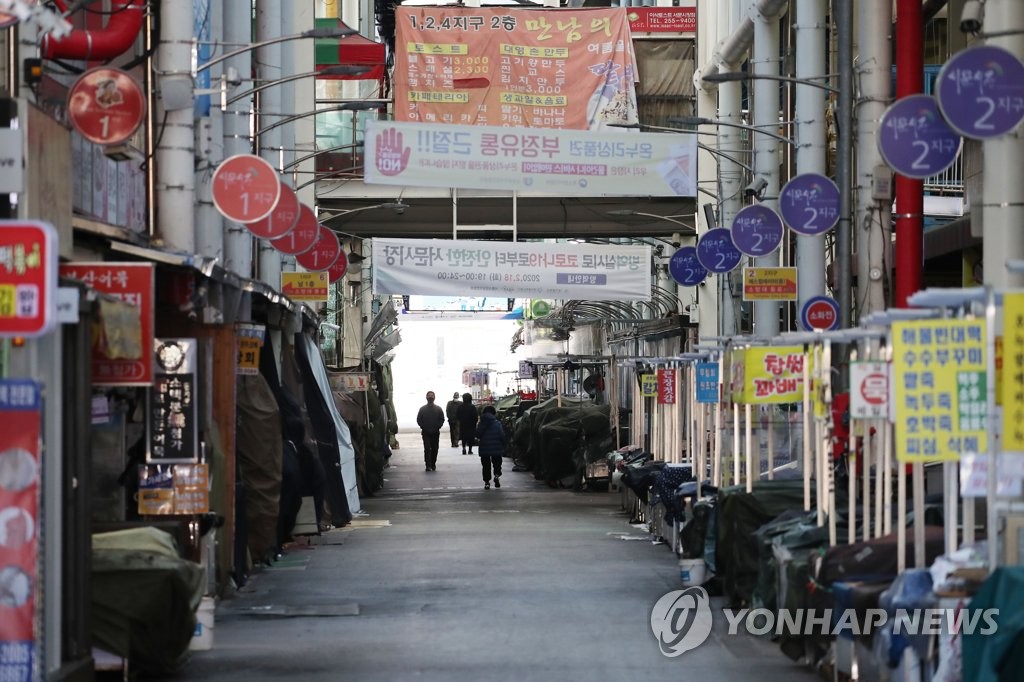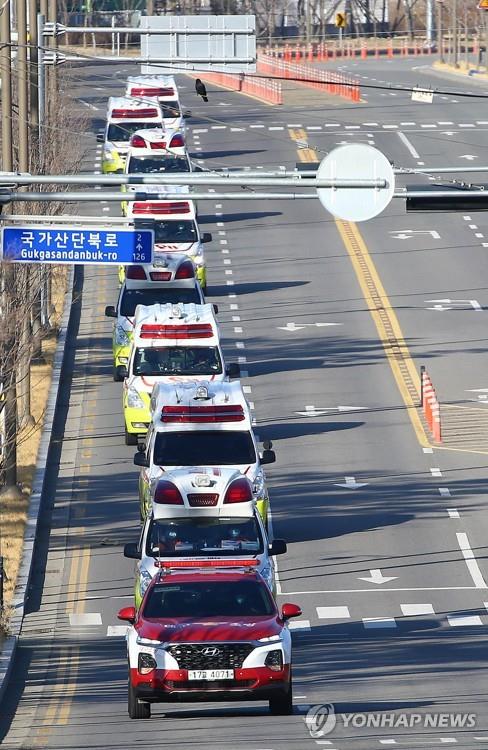- California Assembly OKs highest minimum wage in nation
- S. Korea unveils first graphic cigarette warnings
- US joins with South Korea, Japan in bid to deter North Korea
- LPGA golfer Chun In-gee finally back in action
- S. Korea won’t be top seed in final World Cup qualification round
- US men’s soccer misses 2nd straight Olympics
- US back on track in qualifying with 4-0 win over Guatemala
- High-intensity workout injuries spawn cottage industry
- CDC expands range of Zika mosquitoes into parts of Northeast
- Who knew? ‘The Walking Dead’ is helping families connect
S. Korea’s virus cases soar to 833, containment of more outbreaks in Daegu in focus
South Korea reported another record daily spike in the number of new coronavirus cases on Monday, and two more deaths from COVID-19, with most new cases centered in the southeastern city of Daegu, where health authorities are shifting the focus of the anti-virus fight to containing its spread.
The 231 additional cases of the new coronavirus brought the total number of infections in South Korea to 833.
The two latest victims of the potentially fatal illness are tied to Daenam Hospital in Cheongdo, near Daegu. Six out of the eight deaths here are linked to the hospital where over 110 people were confirmed to have been infected.
Daegu, where 2.5 million people have been asked to stay indoors, saw its confirmed cases jump by 196 to 483 on Monday, despite efforts to stem the spread of the virus, the Korea Centers for Disease Control and Prevention (KCDC) said in a statement.
Two clusters of infections — at a branch of a religious sect in Daegu and the Cheongdo hospital — have continued to expand sharply, taking up about three-quarters of the total cases in the country. About 60 percent of the total cases are linked to church services at the Daegu-based Shincheonji church and 15 percent to Daenam Hospital in Cheongdo.



A market in Daegu, 300 kilometers southeast of Seoul, is closed on Feb. 23, 2020, to prevent the spread of the new coronavirus. (Yonhap)
Although health authorities voiced hope that the virus can be contained, experts said the virus may have spread more widely nationwide as cases with no clear links to China or confirmed cases continued to be discovered in Seoul and other regions.
The rapid rise of virus cases bodes ill for the Korean economy. Earlier in the day, President Moon Jae-in called for officials to start reviewing whether an extra budget is needed to cushion the impact of the virus on Asia’s fourth-largest economy.
“The government should make special prescriptions for extraordinary economic situations,” Moon emphasized, urging the government to make decisions and take special measures in a swift and aggressive manner with “no restriction on policy-related imagination.”
Vice Health and Welfare Minister Kim Gang-lip told reporters, “If authorities fail to contain the spread of the COVID-19 in Daegu, there is a high possibility that COVID-19 could spread nationwide.”
To beef up the first line of defense, authorities will swiftly find patients with mild symptoms and isolate them, Kim said.
Health authorities will check about 28,000 people in Daegu who show flu symptoms over the past two weeks, officials said.
“This is a stage where nationwide spread is very worrisome when local transmission (in Daegu) expands,” the vice minister said.
With health authorities preemptively isolating potential patients with mild symptoms, Kim said authorities will try to “stabilize the situation within four weeks.”
Despite an alarming surge in confirmed cases in recent days, the government has no plan to expand entry bans on foreign nationals from China’s other provinces, officials said.
Currently, South Korea bans foreign nationals entering the country from China’s Hubei province, the epicenter of the virus outbreak.
A petition calling for President Moon to expand entry bans to China’s other provinces has exceeded 700,000.
KCDC Director General Jeong Eun-Kyeong told reporters that two more virus patients are in critical condition and another 14 patients have been receiving oxygen treatment.
The virus has infected a 16-month-old baby and a four-year-old child, but they are in stable condition, Jeong said.
The government revised its public health guidance, ordering people with fever or respiratory symptoms to stop going to schools and companies and refrain from going outside, she said.
With cases of untraceable virus rising, health authorities also changed their strategy to swiftly find those who came in contact with confirmed carriers, instead of trying to find those who triggered infections, the director general said.
As the virus can spread via people who have mild or few symptoms, it is difficult for authorities to identify a link between existing and new cases, she said.
On Sunday, South Korea raised its virus alert to the highest, or “red,” level — the first time it has done so since the 2009 outbreak of H1N1 swine flu.
The top alert level allows authorities to order the temporary shutdown of schools and cut flights to and from South Korea.
The education ministry has instructed all kindergartens and schools to delay the beginning of the spring semester by one week to March 9 in an effort to prevent the virus from spreading more widely, after the first case was reported on Jan. 20.
Of the 231 new cases confirmed on Monday, 205 are in Daegu, 300 kilometers southeast of Seoul, and neighboring North Gyeongsang Province. Another four were reported in Seoul, the KCDC said in a statement.
Authorities said they have acquired a list of members from the Daegu-based Shincheonji church and are closely monitoring them.
The KCDC earlier said it has placed more than 9,334 Shincheonji members in self-quarantine. Of them, 1,248 have shown COVID-19-related symptoms.
On Monday, Busan and Gwangju reported 14 more cases and one more case, respectively. Seoul’s neighboring Gyeonggi Province reported 12 more cases, the KCDC said. Daejeon and Ulsan also reported one case each.
South Korea confirmed its first new coronavirus case from a Chinese woman from the Chinese central city of Wuhan at the epicenter of the virus outbreak on Jan. 20.
South Korea released four more novel coronavirus patients Monday after they were declared virus-free, bringing the total number of fully recovered patients here to 22, the KCDC said.
The number of people being checked for the virus and under quarantine came to 11,631, it added. The country had tested a total of 31,923 suspected cases as of 4 p.m. Monday, with 20,292 testing negative.








![일본 사도광산 [서경덕 교수 제공. 재판매 및 DB 금지]](http://www.koreatimesus.com/wp-content/uploads/2024/07/PYH2024072610800050400_P4-copy-120x134.jpg)


